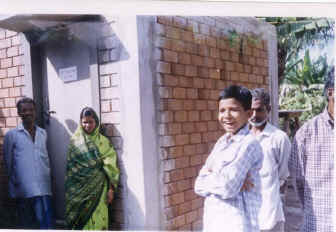Acceptance of New Technology
The first stone was laid on 10th of October 2000. By mid-November, the first set of houses had been built at Astanrang and Balikuda.
Initially, reactions to the new materials were skeptical and disbelief; "What kind of funny profiled roofs are these, a monkey jumps on it, and it will break". "Are these bricks?, you are not even putting them into the fire, these will dissolve?". This is what the local people of this remote village where the Building Material and Services Bank is located said yesterday. Today they say "Please get the channels lifted fast and complete our house before the rains. We don’t want to face this monsoon without proper shelter". "The blocks used in my house are stronger than in his house…."
They have their own ingenious ways of testing the strength of the products and technology by keeping the earth block submerged in water for weeks together and satisfaction comes when they see that the block does not dissolve.

In Ashraya, the levels of acceptance and awareness of the new technologies of Ferrocement Channels and Compressed Earth Blocks has grown, albeit slowly.
Durjadhan Mallick is all smiles when he says; "Madam, today my son opened the rain water pipe (RWP) and cleared the terrace of the stagnant rain water and not a single drop seeped through my roof". It was his reaction to yesterday night incessant rain. After terrace works, he had forgotten to open the RWP which was closed for curing. His son remembered the next morning and cleared the RWP.
There was a lurking fear somewhere in his mind that the new technology of roofing channels is not as good as the conventional slab - but now he can sleep satisfied. In Building Material Service Banks they make the products themselves and these are used for building their own shelters.
Can we now conclude that the community in these remote Oriya villages understands that these bricks are the Compressed Earth Blocks and those funny profiled roof units are the Ferrocement Channels which can make their houses faster and stronger and can save them from the fury of rains and winds.
Housing Delivery
There are two ways of looking at the progress against the targetted number of houses. The time frame has been extended beyond the donor specified deadline. But in the process all levels of partners, from the BMSB managers and production staff to masons and village families have experienced an upgradation of skills and capacities. In any case the DA team feels that the acceleration in the rate of house construction is satisfactory. We feel a great sense of achievement in seeing local artisans and NGO partners undertaking the project now with only trouble shooting and guidance from the technical experts.
Roles and Responsibilities
It is interesting, how partners who have been intensively involved together in the process have often varying and at times diametrically opposite approaches, often heard for e.g..."Is the program to build these many houses only? Or is it building up a process? or is it both?". "When can we meet the time targets? How many houses and by when? We are ‘giving’ people enough – there can be no complaints.
"Just do it now and forget about any alternations". "We need individual and organisational commitments. The ‘whole’ process needs to be pursued we can only succeed if we are transparent and carry the families with us". "Family pass books are essential records – these must be maintained and a copy to be used for documentation and learnings".
"Quality must not be compromised for speed. Let us not be technology loyal but process loyal and pursue the sustainability of the process".
The Larger Purpose
It is clear that the task is as much to demystify technology and simplify the process for practical usage as it is to build consensus at field and at management levels.
From the point of view of a ‘trainer’ passing out skills and know-how, it is extensively satisfying when recipients value their new knowledge.
Masons such as Chandra at Astrang, who was unable to attend the formal program, seek the drawings and literature and want to prove their skills on field and achieve a certificate. The new skills have a market value, and Chandra wants to ensure he has a ‘paper’ to show his future clients that can fetch him a higher wage. Supervisors too want mason’s training course programs and certificates.
Today there are around 600 houses in various stages of construction. Although we are yet to experience the zenith of the process, the making of it is on its way. And no process can be achieved in a single day and we understand that numbers built and targets achieved matter. q